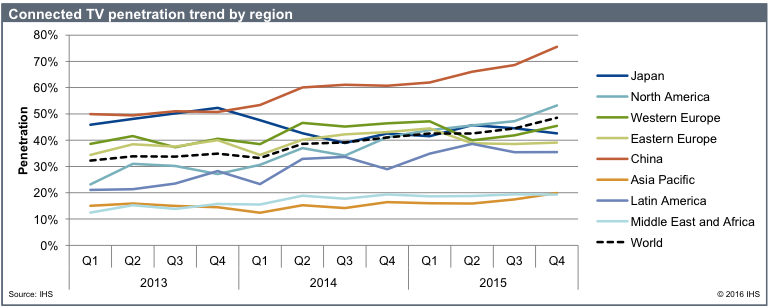Smart TV shipments exceed 100 million units in 2015
Thursday, May 19th, 2016
China Dominates Smart TV Market as North America Surges, IHS Says
- For the first time, smart TV shipments exceeded 100 million units in 2015
ENGLEWOOD, Colo. — Worldwide shipments of smart TVs in the fourth quarter of 2015 reached 48.5 percent of all TV sets shipped in the quarter. In all, 34.2 million smart TVs were shipped in the fourth quarter, contributing to shipments breaking the 100 million mark for the first time in 2015, according to IHS Inc. (NYSE: IHS), the leading global source of critical information and insight. Smart TV shipments will reach 109 million in 2016, rising to 134 million in 2020.
“Consumers increasingly regard smart functions as essential,” said Paul Gray, principal analyst, IHS Technology. “The market dynamic has shifted from seeding the market to self-sustaining demand for built-in internet streaming functions.”

More than three-quarters of televisions in China were shipped with smart functionality in 2015, while in North America the popularity of the feature surged from 36 percent to 48 percent. The popularity of Netflix and other services is reinforcing demand in North America, according to the IHS Technology TV Design and Features Tracker.
It is a mixed picture in other regions. Latin America continues to strongly increase smart TV shipments, despite a depressed television market. Penetration was diluted by basic TV sets, to subsidize Mexico’s digital switchover. Excluding such sets, more than half of TVs shipped in Latin America in the fourth quarter of 2015 included smart features. Japan and Europe appear to have reached a plateau, with small declines in 2015, largely due to the end of aggressive promotion campaigns by TV brands and a shortage of good local content.
“Smart TV will continue to grow at a more gradual rate,” Gray said. “China, the dominant engine of smart TV growth, has little extra room to grow. Other developed markets are increasingly saturated, while lack of broadband internet connections remains an issue in emerging regions.”
Latest News
- Barb to start reporting TV-set viewing of YouTube channels
- SAT FILM selects multi-DRM from CryptoGuard
- Qvest and ARABSAT to launch OTT streaming platform
- ArabyAds & LG Ad Solutions partner with TVekstra in Turkey
- Freeview NZ satellite TV service to move to Koreasat 6
- Comscore expands YouTube CTV measurement internationally
